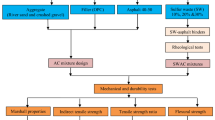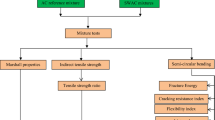Abstract
With the development of the road pavement industry and increasing traffic on streets, construction materials have likewise been developed and progressively non-conventional materials have been incorporated. The main idea behind the utilization of those non-conventional materials was the shortage of natural materials and their expensive cost which have supported the inclination towards the inclusion of waste and marginal materials that has also assisted in achieving environmental sustainability in asphalt pavement design and construction. Researches have shown that there is a variety of waste materials that can be used effectively in different layers of pavement system such as oil shale ash (OSA). OSA is considered undesirable and environmentally dangerous as a byproduct of direct combustion or retorting of oil shale. However, research has recently shown that this ash has many benefits that improve the asphalt mixture. Accordingly, this paper presents a systematic review of the performance evaluation of different types of OSA modified asphalt cement and asphaltic concrete mixes, in terms of the most successful ratio to be added and the extent to which the properties of asphalt mixtures were affected by this addition. It was concluded that there is a consensus among the researchers that adding OSA to concrete mixture improved its conventional and rheological properties and reduced its potential for stripping and creep damaging, where the optimum ratio of OSA to be added was recommended to be in the range of 5–15% by the volume of binder.
Similar content being viewed by others
References
Sutradhar, D., Miah, M., Chowdhury, G. J., & Sobhan, M. A. (2015). Effect of using waste material as filler in bituminous mix design. American Journal of Civil Engineering, 3(3), 88–94.
Aljassar, A., Metwali, S., & Ali, M. (2004). Effect of filler types on marshall stability and retained strength of asphalt concrete. International Journal of Pavement Engineering, 5(1), 47–51.
Tapkın, S. (2008). Mechanical evaluation of asphalt–aggregate mixtures prepared with fly ash as a filler replacement. Canadian Journal of Civil Engineering, 35(1), 27–40.
Jamshidi, A., & White, G. (2019). Use of recyclable materials in pavement construction for environmental sustainability. In The eighteenth annual international conference on pavement engineering, asphalt technology and infrastructure., U.K.
Khedaywi, T., Al Kofahi, N., & Al-Zoubi, M. (2020). Effect of olive waste ash on properties of asphalt cement and asphalt concrete mixtures. International Journal of Pavement Research and Technology. https://doi.org/10.1007/s42947-020-0254-2.
Abukhettala, M. (2016). Use of recycled materials in road construction. In Proceedings of the 2nd international conference on civil, structural and transportation engineering (ICCSTE’16), Canada.
Lin, D., Lin, J., & Chen, S. (2006). The application of baghouse fines in Taiwan. Resources, Conservation and Recycling, 46(3), 281–301.
Katamine, N. (2000). Phosphate waste in mixtures to improve their deformation. Journal of Transportation Engineering, 126(5), 382–389.
Sung Do, H., HeeMun, P., & Su keun, R. (2008). A study on engineering characteristics of asphalt concrete using filler with recycled waste lime. Waste Management, 28(1), 191–199.
Asi, I., & Assa’ad, A. (2005). Effect of Jordanian oil shale fly ash on asphalt mixes. Journal of Materials in Civil Engineering, 17(5), 553–559.
Huang, B., Dong, Q., & Burdette, E. (2009). Laboratory evaluation of incorporating waste ceramic materials into Portland cement and asphaltic concrete. Construction and Building Materials, 23(12), 3451–3456.
Xue, Y., Hou, H., Zhu, S., & Zha, J. (2009). Utilization of municipal solid waste incineration ash in stone mastic asphalt mixture: pavement performance and environmental impact. Construction and Building Materials, 23(2), 989–996.
Khedaywi, T. S., & Abu-Orabi, S. T. (1989). Effect of oil shale ash, rubber ash, husk ash, and polyethylene on properties of asphalt cement. Journal of Petroleum, 8(2), 193–206.
Smadi, M., Yeginobali, A., & Khedaywi, T. (1989). Potential uses of Jordanian spent oil shale ash as a cementive material. Magazine of Concrete Research, 41(148), 183–190.
Turner, J. P. (1994). Soil stabilization using oil-shale solid waste. Journal of Geotechnical Engineering, 120(4), 646–660.
Assa’ad, A. (2003). Oil shale direct combustion and the use of fly ash for the soil stabilization. Dirasat Jordan University, 30(1), 146–161.
Abu-Hamatteh, Z., & Al-Shawabkeh, A. (2008). An overview of the Jordanian oil shale: its chemical and geologic characteristics, exploration, reserves and feasibility for oil and cement production. Central European Geology, 51(4), 379–395.
Eldermann, M., Siirde, A., & Gusca, J. (2017). Decarbonisation of estonian oil shale industry: framework and categories definition. Energy Procedia, 113, 77–81.
Reinik, J., Irha, N., Koroljova, A., & Meriste, T. (2018). Use of oil shale ash in road construction: results of follow-up environmental monitoring. Environmental Monitoring and Assessment, 190(2), 59.
Gale, J. F., Laubach, S. E., Olson, J. E., Eichhubl, P., & Fall, A. (2014). Natural fractures in shale: a review and new observations natural fractures in shale: a review and new observations. AAPG Bulletin, 98(11), 2165–2216.
Al-Qadi, Q. N., Al-Qadi, A. N., & Khedaywi, T. S. (2014). Effect of oil shale ash on static creep performance of asphalt-paving mixtures. Jordan Journal of Earth and Environmental Sciences, 6(2), 67–75.
Wang, W., Cheng, Y., Tan, G., & Shi, C. (2018). Pavement performance evaluation of asphalt mixtures containing oil shale waste. Road Materials and Pavement Design, 21(1), 179–200.
Wang, W., Cheng, Y., Tan, G., Liu, Z., & Shi, C. (2018). Laboratory investigation on high- and low-temperature performances of asphalt mastics modified by waste oil shale ash. Journal of Material Cycles and Waste Management, 20(3), 1710–1723.
Han, X., Kulaots, I., Jiang, X., & Suuberg, E. (2014). Review of oil shale semicoke and its combustion utilization. Fuel, 126, 143–161.
Guo, X., Chen, X., Li, Y., Li, Z., & Guo, W. (2019). Using sustainable oil shale waste powder treated with silane coupling agent for enriching the performance of asphalt and asphalt mixture. Sustainability, 11(18), 4857.
Parvez, M. A., Wahhab, H. I. A. A., Shawabkeh, R. A., & Hussein, I. A. (2014). Asphalt modification using acid treated waste oil fly ash. Construction and Building Materials, 15, 201–209.
Ahsan, M. B., & Hossain, Z. (2018). Effect of particle size of rice husk ash (RHA) in mitigating alkali silica reaction (ASR) in concrete pavement. International Journal of Pavement Research and Technology, 11(8), 861–866.
Smadi, M., & Haddad, R. (2003). The use of oil shale ash in Portland cement concrete. Cement and Concrete Composites, 25(1), 43–50.
Nov, S., Cohen, H., & Knop, Y. (2020). Treated oil shale ashes as a substitute for natural aggregates, sand, and cement in concrete. Israel Journal of Chemistry, 60(5), 638–643.
Khedaywi, T., Yeginobali, A., Smadi, M., & Cabrera, J. (1990). Pozzolanic activity of Jordanian oil shale ash. Cement and Concrete Research, 20(6), 843–852.
Liira, M., Kirsimäe, K., Kuusik, R., & Mõtlep, R. (2009). Transformation of calcareous oil-shale circulating fluidized-bed combustion boiler ashes under wet conditions. Fuel, 88(4), 712–718.
Reinik, J., Irha, N., Steinnes, E., Urb, G., Jefimova, J., Piirisalu, E., & Loosaar, J. (2013). Changes in trace element contents in ashes of oil shale fueled PF and CFB boilers during operation. Fuel Processing Technology, 115, 174–181.
Batkhuyag, S., & Yondongombo, G. (2012). What are shale oil, shale gas and oil shale? Mongolian Mining Journal, 24.
IEA. (2013). Energy policies beyond IEA countries: Estonia 2013. IEA/OECD Publishing. https://doi.org/10.1787/9789264190801-en. Accessed 13 Aug 2020.
IEA. (2016). World energy statistics and balances (database). http://stats.oecd.org/Index.aspx?DataSetCode=WBAL. Accessed 2 Aug 2020.
Gavrilova, O., Vilu, R., & Vallner, L. (2010). A life cycle environmental impact assessment of oil shale produced and consumed in Estonia. Resources, Conservation and Recycling, 55(2), 232–245.
Organization for Economic Cooperation and Development (OECD). (2017). OECD environmental performance reviews: Estonia 2017. Mining and the environment. https://www.oecd-ilibrary.org/sites/9789264268241-12-en/index.html?itemId=/content/component/9789264268241-12-en#bxsec1-0011. Accessed 22 Aug 2020.
Paiste, P., Liira, M., Heinmaa, I., Vahur, S., & Kirsimäe, K. (2016). Alkali activated construction materials: assessing the alternative use for oil shale processing solid wastes. Construction and Building Materials, 122, 458–464.
National Development Plan for the Use of Oil Shale 2008–2015. http://www.envir.ee/sites/default/files/polevkivi_kasutamise_arengukava_2008_2015.pdf. Accessed 2 Aug 2020.
National Development Plan for the Use of Oil Shale 2016–2030. https://www.envir.ee/sites/default/files/2016_2030ak_ingl.pdf. Accessed 2 Aug 2020.
Eesti Energia AS, Project: LIFE+ 09/ENV/000227 OSAMAT. Final Technical Report. Resource document. Eesti Energia AS, 2016. www.osamat.ee/en/documents/aasta2011-dokumendid/68-osamat-final-report151116.html. Accessed 2 Aug 2020.
Truu, M. (2015). Technical monitoring and scientific analysis of data from OSAMAT project pilot sections. Final report. Resource document. Teede Tehnokeskus. http://www.osamat.ee/en/documents/aasta-2015-dokumendid/44–4.html. Accessed 15 Aug 2020.
Ghuzlan, K., Al-Khateeb, G., & Damrah, A. (2013). Using oil shale ash waste as a modifier for asphalt binders. Journal of Material Cycles and Waste Management, 15(4), 522–529.
Khedaywi, T. S. (1988). Effect of inclusion of oil shale ash on behavior of asphalt concrete. Transportation Research Record, 1171, 199–205.
Al-Masaeid, H. R., Khedaywi, T. S., & Samadi, M. (1989). Properties of asphalt-oil shale ash bituminous mixtures under normal and freeze-thaw conditions. Transportation Research Record, 1228, 54–62.
Rahman, M. N., & Sobhan, M. A. (2013). Use of non-conventional fillers on asphalt-concrete mixture. International Journal of Innovation and Applied Studies, 3(4), 1101–1109.
Azzam, M., & Al-Ghazawi, Z. (2015). Evaluation of incorporating oil shale filler aggregate into hot mix asphalt using Superpave mix design. Construction and Building Materials, 101, 359–379.
Author information
Authors and Affiliations
Corresponding author
Rights and permissions
About this article
Cite this article
Khedaywi, T., Khaled, F. Effect of Waste Oil Shale Ash on Properties of Asphalt Cement and Asphalt Concrete Mixtures: State of the Art. Int. J. Pavement Res. Technol. 15, 111–123 (2022). https://doi.org/10.1007/s42947-021-00002-8
Received:
Revised:
Accepted:
Published:
Issue Date:
DOI: https://doi.org/10.1007/s42947-021-00002-8







